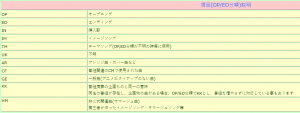Anison: Difference between revisions
(New page: {{TOCright}} ==What is Anison?== Anison is a japanese '''Ani'''me '''Son'''gDB AniDB wants you to use when adding Songs or Collections. ==Where do I find Anison?== The [http://anison.info/...) |
(No difference)
|
Revision as of 22:29, 29 June 2009
What is Anison?
Anison is a japanese Anime SongDB AniDB wants you to use when adding Songs or Collections.
Where do I find Anison?
The Original Page is a bit messy and makes people who aren't familiar with Japanese click around quite a lot before finding this page, which is the one we "offer" on the add templates.
I have no idea what the page tells me...
That's no problem because that's what this pretty wiki page is here for. To explain to you - the willing user - how to use Anison with its features you may not know of.
The Legend

Before explaining the four different ways of searching it's better to go through the legend Anison provides on its front page.
| Anison Original Shorty | Anison Original Explanation | Romaji | English Translation | Extra Explanation |
|---|---|---|---|---|
| OP | オープニング | Oopeningu / Opening | Opening | marked song's been an opening song |
| ED | エンディング | Endingu / Ending | Ending | marked song's been an ending song |
| IN | 挿入歌 | Sounyuu Uta | Insert Song | marked song's been played in an Anime at some point as an insert song |
| IM | イメージソング | Imeeji Songu / Image Song | Image Song | marked song's been written for the Anime / with the Anime in mind and didn't actually show up in the Anime (!!rare cases say different!!) |
| TM | テーマソング(OP,ED分類が不明の時等に使用) | Teema Songu / Theme Song (OP, ED Bunrui ga Fumei no Tokira ni Shiyou) | Theme Song (OP, ED Category gets used sometimes) | A theme song is either a repeated theme for a character or for the Anime itself but can also be the opening or ending song of a movie (and gets just called Theme Song). |
| UK | 不明 | Fumei | unidentified / unknown | marked song's unknown which "role" it played |
| AR | アレンジ曲・カバー曲など | Arenji / Arranged Kiyoku - Kabaa / Cover Kiyoku Nado | Arranged Piece of Music / Cover Piece of Music and similiar | marked song's instrumental or a cover of another song |
| CF | 番組関連のCMで使用された曲 | Bangumi Kanren no CM de Shiyousareta Kiyoku | Piece of Music that's used in TV related Commercials | - |
| GE | 一般曲(アニメ系タイアップのない曲) | Ippan Kiyoku (Anime Kei Taiappu / Type no nai Kiyoku) | normal/ordinary piece of music (they type that's not been used with an Anime relation) | marked song hasn't been used for an Anime (but is still listed in Anison) |
| KK | 番組摘要の企画ものと同一の意味 同名の番組が存在し、企画物の曲がある場合、OP/ED分類でKKとし、番組を増やさずに対応している事もあります |
Bangumi Tekiyou no Kikakumono to Douitsu no Imi - Doumyou no Bangumi ga Sonzaishi, Kikakumono no Kiyoku ga Aru Baai, OP/ED Bunrui de KK Toshi, Bangumi o Zouya Sazuni Taioushiteiru Koto mo Arimasu |
How do I find stuff?!
As it's a Japanese Website you need to use Japanese as input (or the pseudo-japanese English - case dependable)
The search Engine
Under the search field are 4 different markable choices. Those are:
- 作品
- 曲
- 人物
- 音源
Those specify the meaning of what you put in the search field.
Hint 1 Anison doesn't like spaces at the beginning of a search string
作品 (Sakuhin)...
... means nothing else than Production or Work. In other words: use this to search for the Anime's name.
Hint 2 Easily take the Anime's name from its AniDB page but don't forget that you can also search with only half the name and still get results shown. As soon as there's numbers or for example a ~ in the Anime's name, better leave that whole part out as Anison may not have information about the Anime with that exact name
Hint 3 When the original title is in English try the name with spaces in between or without. You may get a result then.
曲 (Kiyoku)...
...means Piece of Music. This field is helpful when you know the name of the song already in its Kanji/Kana form.
人物 Jinbutsu...
...is a field where you can insert a person's name that worked on the song of your choice. It can be a lyricist, an arranger, the performing band, the singer/songstress aso. Use this field when you don't know the song's name nor the Anime it belongs to, but the Performer.
音源 (Ongen)...
...translates to "Sound Source" and means the name of the Collection (Single, Album) your song is on. Use this field when you try to find a Soundtrack entry for example, which you couldn't find yet with other methods.
Hint 4 When the Collection you're looking for is a Soundtrack just put the Anime's Name in the search field. Anison will list you every Single/Album in its DB that has your search string as a part in its name.